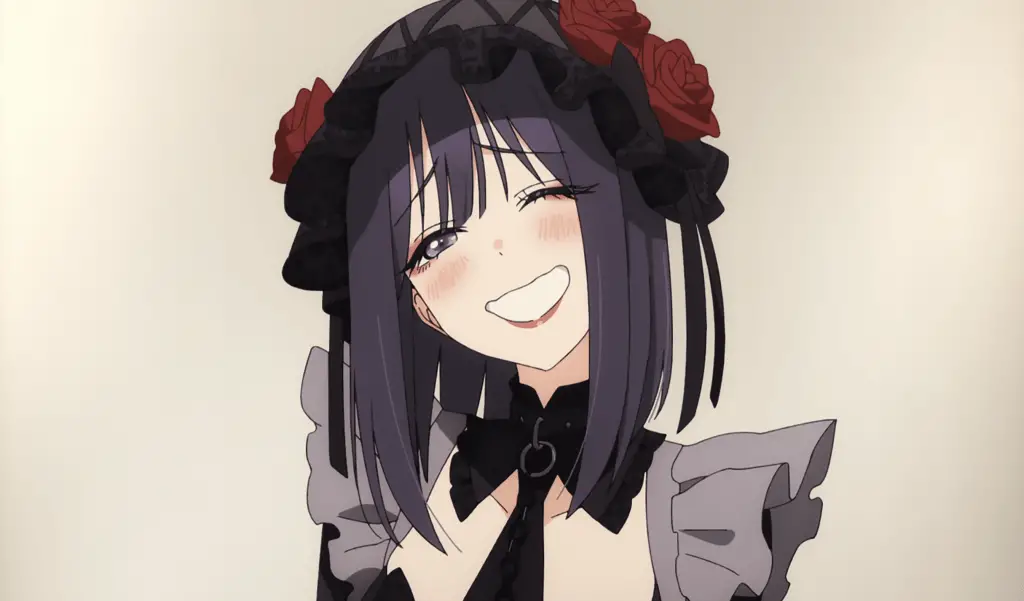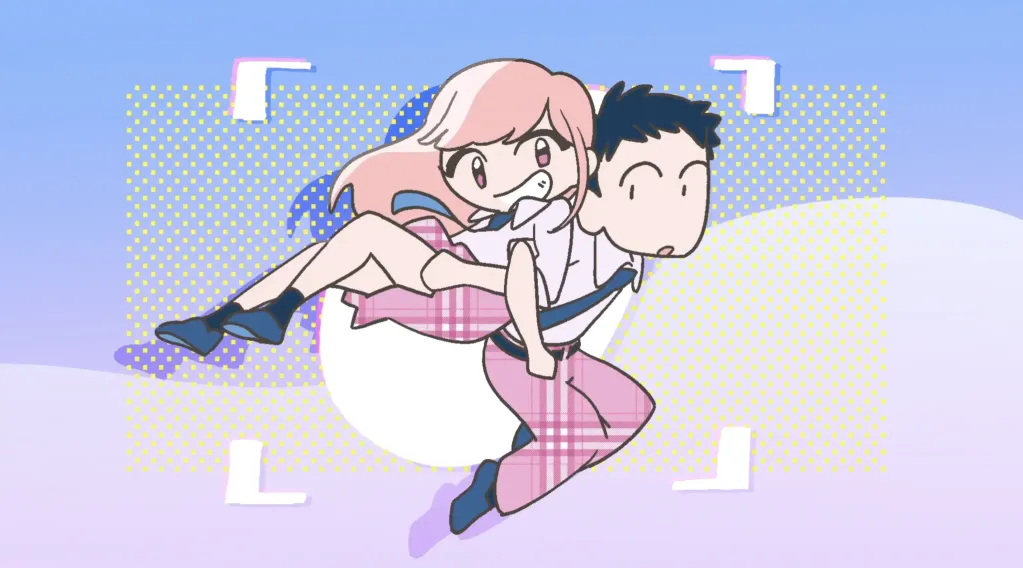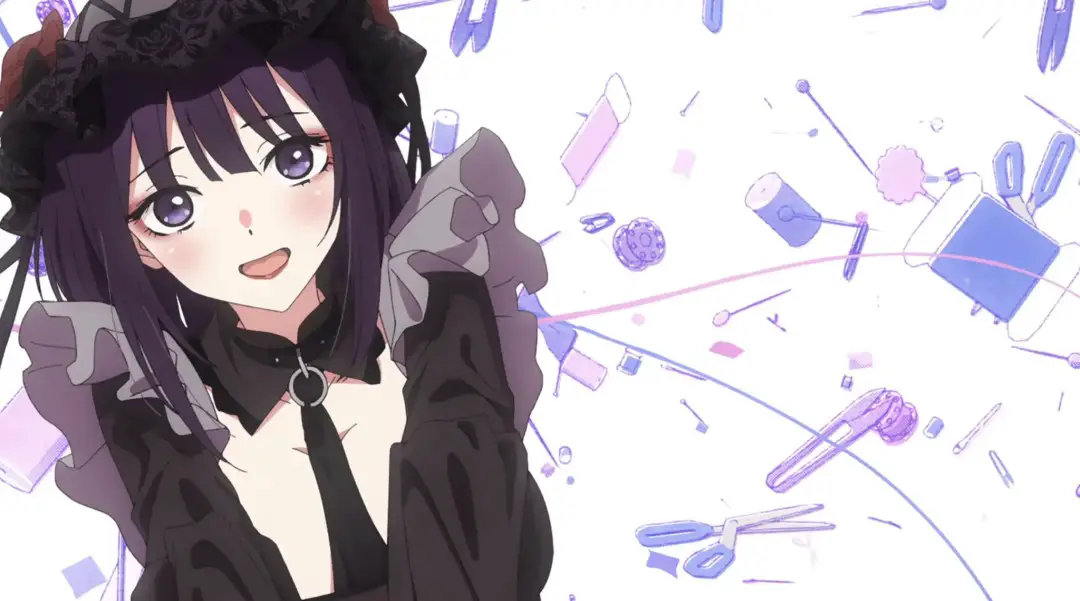My Dress-Up Darling is a fun and cute romantic comedy anime series. It revolves around cosplay, a hobby close to the heart of anime otaku culture. Quite a few anime fans make or wear cosplay outfits to events. Many of those who don’t cosplay themselves have probably taken cosplayer photos at conventions. There have been anime shows which feature cosplay before, but in this My-Dress Up Darling anime review, we’ll explain why this is one of the better ones.
Table of Contents
- The Basics
- How The Story Begins
- Cosplay and Complications
- More Characters, More Hijinks
- Graphics
- Soundtrack
- Voice Acting
- Final Thoughts
The Basics

Shinichi Fukuda created the first chapter of the My Dress-Up Darling manga in 2018, and the series is still ongoing. Square Enix’s Young Gangan, a seinen (young adult male) manga magazine publishes it. (As we will explain later, the series deserves the seinen, rather than shonen, category.)
The original Japanese title is Sono Bisuku Doru wa Koi o Suru, or the Bisque Doll That Fell in Love. The anime adaptation by CloverWorks first aired in January 2022, and the first season will last 12 episodes. Keisuke Shinohara, who previously directed episodes of Little Witch Academia, Flip Flappers, and PriPara, directs the series.
You can find out where to watch the series online HERE.
How the Story Begins
High school students Wakana Gojo and Marin Kitagawa are the main protagonists in this romantic series.
Gojo is an introverted teen who wants to continue his family’s legacy of traditional Japanese doll making. Unfortunately for him, his classmates don’t get it. They think that his passion for dolls is weird. This leaves him feeling socially awkward and easily embarrassed.
Marin is the exact opposite of Gojo. She’s bubbly, outgoing, perky, and very cheerful. She’s also an otaku girl who wants to be a cosplayer. However, at the beginning of the series, Marin knows very little about the actual process of creating outfits.
When she learns about Gojo and his dolls, she immediately recognizes him as somebody who might be able to help her with her cosplay costume problem.
Gojo accepts the challenge, although he quickly finds that there are definite differences between creating outfits for small, inanimate dolls and making outfits for people.
Cosplay and Complications
The first few episodes delve deep into the details of making cosplay. This includes the embarrassing need to take Marin’s curvy measurements. That is, it’s embarrassing for Gojo. Marin is much more open to the idea, and considerably less embarrassed about it than he is.
The show mines a lot of comedy from these scenes. But it’s also a huge part of the reason why this seinen series gets a TV-14 rating in the United States. Yes, first-time viewers should be aware that the series does contain fanservice (especially in episode 6).
Incidentally, Shizuku-tan, the character who Marin wants to cosplay, is from an adult-themed video game, and this is another source of awkwardness for Gojo.
There’s also some good, goofy comedic scenes when Wakana Gojo’s grandfather accidentally discovers the girly clothes that his grandson brings home. (He eventually figures it out, and even approves of it.)
The first arc of the first season ends with Gojo finishing the outfit, and Marin wearing it at a cosplay event. The episode will seem very familiar to anyone who has ever been to an anime convention.
My Dress-Up Darling Character Review
Sajuna Inui, a.k.a. the cosplayer Juju, joins the cast after the cosplay event. She is quickly followed by her younger sister Shinju, who serves as Sajuna’s photographer and helper.
With her aloof, tsundere personality, Sajuna is definitely different from the others. She is initially unwilling to cosplay together with Marin, and seems only interested in Gojo’s costume making skills. However, she does eventually manage to get along with Marin because they both take cosplaying seriously. On the other hand, Shinju is more shy and nice.
Busty middle school student Shinju adds to Gojo’s embarrassment when she decides she wants to cosplay — especially as she wants to crossplay as a male character.
While the primary focus is still on Marin and Gojo’s growing relationship, more cosplayers means more chances to demonstrate some behind-the-scenes cosplay tricks. And that includes more opportunities for embarrassing, comedic moments.
Graphics

As a relatively realistic, slice-of-life romantic comedy anime series, My Dress-Up Darling is considerably less stylized than some anime series. It’s not a shonen series.
Given the series’ cosplay theme, it makes sense that it would pay attention to makeup and costume details.
Of course, the anime isn’t above some wild reactions and more cartoony expressions when needed. Marin is a gold mine of funny, genki girl expressions. (It’s especially funny when Marin’s happy face doesn’t match the gothic lolita style of her cosplay character.)
And you can really feel Gojo’s awkwardness every time that he’s exposed to something he feels like he shouldn’t be seeing.
My Dress-Up Darling Soundtrack Review
While you’re probably not going to watch a series like My Dress-Up Darling specifically for the music, the opening and ending themes are good and appropriate for the series. The opening theme is Sun Sun Days by J-pop/ rock band Spira Spica. They’ve done anime theme songs before, including the second theme for Gundam Build Divers.
The title is sometimes translated as San San Days, which can also be interpreted literally as Bright Days. Either translation would be an accurate description of the song, which is perky, bright, and sunny.
The ending theme is Koi no Yukue, a cute and quirky pop song by Akari Akase. The title translates as Whereabouts of Love. Personally, I like the ending theme better than the opening.
The ending credits are fun, but you really ought to watch the official music video. Akari Akase is a cosplayer, and she dresses up as Marin in the video. She really looks like the character. Her YouTube channel is full of cosplay-related stuff.
Voice Acting
Hina Suguta performs Marin, while Shouya Ishige is Wakana Gojo. This is Suguta’s first main protagonist role. Ishige was previously Yun in Godzilla S.P., and Yusaku Fujiki in Yu-Gi-Oh! VRAINS. Both of these voice actors are believable as the two polar opposites.
Atsumi Tanezaki portrays Sajuna, and Hina Yomiya is Shinju Inui. Tanezaki will show up as Anya Forger in the upcoming Spy x Family anime series (starting April 2022). She’s also Miu Amano in Blend S, Juno in Beastars, and Arisa in Fruits Basket, among other things.
Yomiya has had fewer roles, but she will play Sakurako in the upcoming shogi comedy anime series When Will Ayumu Make His Move?, a.k.a. Soredemo Ayumu wa Yosetekuru.
Atsushi Ono plays Kaoru Gojo (Gojo’s grandfather). He’s had a lot of supporting roles in series ranging from Naruto to One Punch Man.
In a bit of a casting gag, Sakura Tange, the voice of Sakura in the original 1998 Cardcaptor Sakura, plays the magical girl Mirai in My Dress-Up Darling.
My Dress-Up Darling Review: Final Thoughts

My Dress-Up Darling is a good, fun series. You might enjoy it more if you’re a fan of cosplay, but it holds up well even if you’re not.
Some will take issue with the fanservice. Arguably, most of it isn’t as gratuitous as elsewhere in anime, especially given the costume design context. But the individual viewer will have to make a judgment call.
If you’ve ever gone to a convention, this will help you appreciate the amount of effort that goes into cosplay. Overall, the characters are fun to watch, and the scenarios are believable.
The manga hasn’t finished yet, so there is potential for the anime to continue beyond the first season. I’m glad that Crunchyroll picked it up, because it is worth watching.

